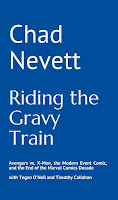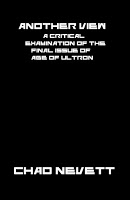[The first of two posts where I'll apply Raymond Chandler's "Twelve Notes on the Mystery Story" to the New X-Men storyarc "Murder at the Mansion."]
Twelve Notes on the Mystery Story (Revised April 18, 1948)
1. It must be credibly motivated, both as to the original situation and the denouement; it must consist of the plausible actions of plausible people in plausible circumstances, it being remembered that plausibility is largely a matter of style. This requirement rules out most trick endings and a great many "closed circle" stories in which the least likely character is forcibly made over into the criminal, without convincing anybody. It also rules out such elaborate mises-en-scene as Christie's Murder in a Calais Coach, where the whole setup for the crime requires such a fluky set of happenings that it could never seem real.
In this respect, the story fails. We get an explanation from Esme as to why she telepathically controlled Angel into shooting Emma Frost: Emma wanted her to be like her and she's not, not at all. That Angel pulled the trigger under the mental control of someone else is a good motivation, but we don't get Esme's true motive here. The mystery is solved except for 'why.'
2. It must be technically sound as to the methods of murder and detection. No fantastic poisons or improper effects from poison such as death from nonfatal doses, etc. No use of silencers on revolvers (they won't work) or snakes climbing bellropes ("The Speckled Band"). Such things at once destroy the foundation of the story. If the detective is a trained policeman, he must act like one, and have the mental and physical equipment that go with the job. If he is a private investigator or amateur, he must at least know enough about police methods not to make an ass of himself. When a policeman is made out to be a fool, as he always was on the Sherlock Holmes stories, this not only depreciates the accomplishment of the detective but it makes the reader doubt the author's knowledge of his own field. Conan Doyle and Poe were primitives in this art and stand in relation to the best modern writers as Giotto does to da Vinci. They did things which are no longer permissible and exposed ignorances that are no longer tolerated. Also, police art, itself, was rudimentary in their time. "The Purloined Letter" would not fool a modern cop for four minutes. Conan Doyle showed no knowledge whatever of the organization of Scotland Yard's men. Christie commits the same stupidities in our time, but that doesn't make them right. Contrast Austin Freeman, who wrote a story about a forged fingerprint ten years before police method realized such things could be done.
It's not a complicated mystery to figure out and the people doing the investigating, Bishop and Sage, do a credible job. They interview possible witnesses, lock down the mansion, and solve the mystery in relative short order.
3. It must be honest with the reader. This is always said, but the implications are not realized. Important facts not only must not be concealed, they must not be distorted by false emphasis. Unimportant facts must not be projected in such a way as to make them portentous. (This creation of red herrings and false menace out of trick camera work and mood shots if the typical Hollywood mystery picture cheat.) Inferences from the facts are the detective's stock in trade; but he should disclose enough to keep the reader's mind working. It is arguable, although not certain, that inferences arising from special knowledge (e.g., Dr. Thorndyke) are a bit of a cheat, because the basic theory of all good mystery writing is that at some stage not too late in the story the reader did have the materials to solve the problem. If specal scientific knowledge was necessary to interpret the facts, the reader did not have the solution unless he had the special knowledge. It may have been Austin Freeman's feeling about this that led him to the invention of the inverted detective story, in which the reader knows the solution from the beginning and takes his pleasure from watching the detective trace it out a step at a time.
Within the confines of this story, I don't think it's entirely honest with the reader. Key facts are hidden, like who points a gun at Sage and then erases her memory. There's a big clue in her first spoken words "Sun in a box!" but that's it. It's a key part of the mystery and to Esme's motives, but it's left out. Otherwise, we learn everything basically at the same time as Bishop and Sage. The only big leap is to Esme, but that can be explained by telepathic traces or something like that. The time jump between them learning it and us learning it when they confront Esme is standard in mystery stories.
4. It must be realistic as to character, setting, and atmosphere. It must be about real people in the real world. Very few mystery writers have any talent for character work, but that doesn't mean it is not necessary. It makes the difference between the story you reread and remember and the one you skim through and almost instantly forget. Those like Valentine Williams who say the problem overrides everything are merely trying to cover up their own inability to create character.
There are plenty of 'real' characters here. Beak confessing to protect the mother of his weird little hatchlings. The role of the Kick drugs and Esme's anger at Emma Frost are true to that character as the 'black sheep' of the Stepford Cuckoos. Bishop and Sage are professional, a little cold, but definitely true to how they've usually been presented. So much of this mystery is rooted in the characters and their weird little problems. In fact, less character would make it a whole lot simpler.
5. It must have a sound story value apart from the mystery element; i.e., the investigation itself must be an adventure worth reading.
It's a Grant Morrison comic. "Does it have value beyond the basic plot and solution to the mystery?" Yes. Yes, it does. It's an entertaining little read where he used a couple of characters he hadn't yet and planted seeds for the upcoming bigger stories to conclude his run on the book.
6. To achieve this it must have some form of suspense, even if only intellectual. This does not mean menace and especially it does not mean that the detective must be menaced by grave personal danger. This last is a trend and like all trends will exhaust itself by overimitation. Nor need the reader be kept hanging on the edge of his chair. The overplotted story can be dull too; too much shock may result in numbness to shock. But there must be conflict, physical, ethical or emotional, and there must be some element of danger in the broadest sense of the word.
There's suspense in whether or not Emma will stay dead; suspense in the idea that someone at the school would shoot a teacher; suspense in the myster surrounding the drug Kick; suspense surrounding Beak's false confession. And, of course, suspense when someone points a gun at one of the detectives.
7. It must have color, lift, and a reasonable amount of dash. It takes an awful lot of technical adroitness to compensate for a dull style, although it has been done, especially in England.
Morrison is anything but dull.
8. It must have enough essential simplicity to be explained easily when the time comes. (This is possibly the most often violated of all the rules). The ideal denouement is one in which everything is revealed in a flash of action. This is rare because ideas that good are always rare. The explanation need not be very short (except on the screen), and often it cannot be short; but it must be interesting in itself, it must be something the reader is anxious to hear, and not a new story with a new set of characters, dragged in to justify an overcomplicated plot. Above all the explanation must not be merely a long-winded assembling of minute circumstances which no ordinary reader could possibly be expected to remember. To make the solution dependent on this is a kind of unfairness, since here again the reader did not have the solution within his grasp, in any practical sense. To expect him to remember a thousand trivialities and from them to select that three that are decisive is as unfair as to expect him to have a profound knowledge of chemistry, metallurgy, or the mating habits of the Patagonian anteater.
Because we don't get Esme's complete motive, this doesn't work entirely. It falls apart until that point: Esme telepathically controlled Angel into shooting Emma Frost because [no reason]. How we get this information is almost in a comedy of errors and then a more traditional confrontation, all of it interesting with a dash of suspense.
9. It must baffle a reasonably intelligent reader. This opens up a very difficult question. Some of the best detective stories ever written (those of Austin Freeman, for example) seldom baffle an intelligent reader to the end. But the reader does not guess the complete solution and could not himself have made a logical demonstration of it. Since readers are of many minds, some will guess a cleverly hidden murder and some will be fooled by the most transparent plot. (Could the "Red-Headed League" ever really fool a modern reader?) It is not necessary or even possible to fool to the hilt the real aficionado of mystery fiction. A mystery story that consistently did that and was honest would be unintelligible to the average fan; he simply would not know what the story was all about. But there must be some important elements of the story that elude the most penetrating reader.
Did anyone guess 'Esme with the pistol in Angel's brain?' No? Okay, it fooled people.
10. The solution must seem inevitable once revealed. This is the least often emphasized element of a good mystery, but it is one of the important elements of all fiction. It is not enough merely to fool or elude or sidestep the reader; you must make him feel that he ought not to have been fooled and that the fooling was honorable.
I'm not sure it satisfies this requirement. With the motive missing, there's nothing inevitable about the solution. While simple to explain, it's also too convoluted to fit this criteria even if we knew the motive.
11. It must not try to do everything at once. If it is a puzzle story operating in a rather cool, reasonable atmosphere, it cannot also be a violent adventure or a passionate romance. An atmosphere of terror destroys logical thinking; if the story is about the intricate psychological pressures that lead apparently ordinary people to commit murder, it cannot then switch to the cool analysis of the police investigator. The detective cannot be hero and menace at the same time; the murderer cannot be a tormented victim of circumstance and also a heavy.
I think this is straight forward enough: a variation on the locked room mystery with a straight ahead investigation. Esme, though, tries to play the victim and the heavy, but that works. She tries one tact until it doesn't work and, then, switches to the other.
12. It must punish the criminal in one way or another, not necessarily by operation of the law. Contrary to popular (and Johnston Office) belief, this requirement has nothing much to do with morality. It is a part of the logic of detection. If the detective fails to resolve the consequences of the crime, the story is an unresolved chord and leaves irritation behind it.
There is no punishment here.
To be continued with Chandler's addenda in 30 minutes...
[Don't forget to donate what you can to the Hero Initiative! (Details in this post.) After you do, let me know via comment or e-mail (found at the righthand side) so I can keep track of donations -- and who to thank.]
Fall of the House of X #4 annotations
14 hours ago






